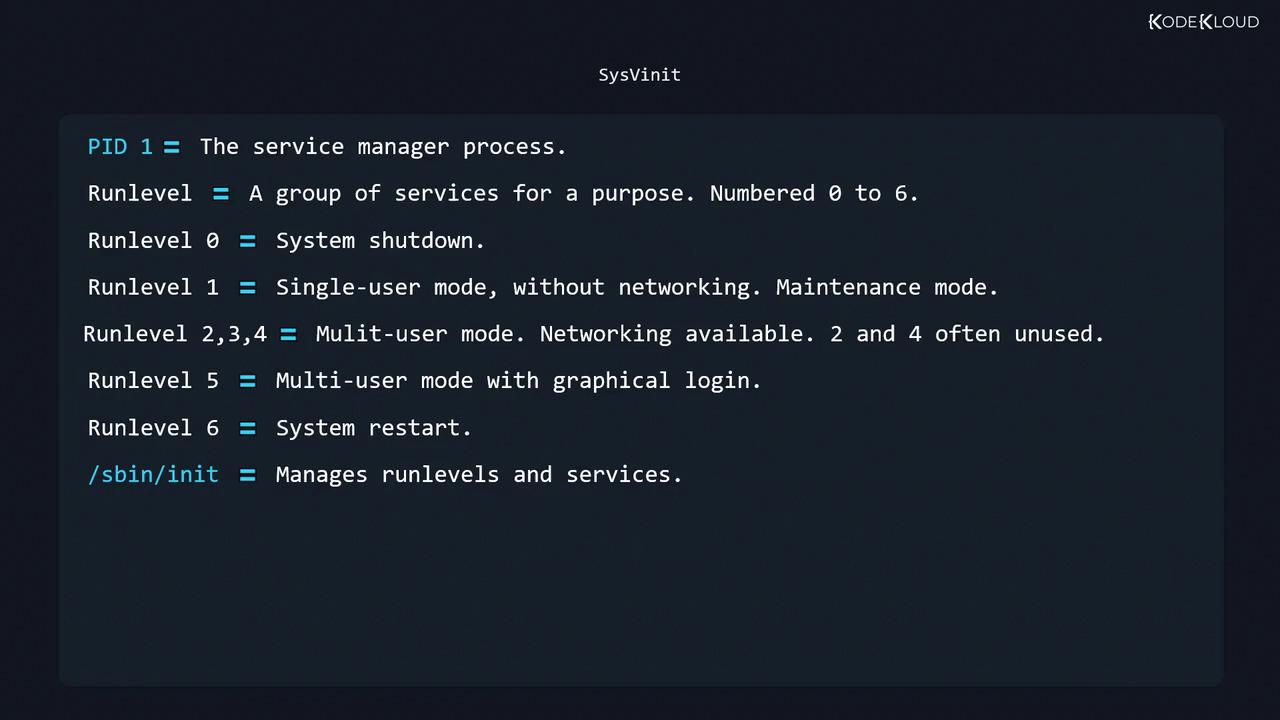Linux Professional Institute LPIC-1 Exam 101
System Architecture
Change Runlevels Boot Targets and Shutdown or Reboot System
In this lesson, we’ll cover how to manage runlevels with SysV init, configure boot targets, and perform system shutdown or reboot. Controlling which services start or stop is essential for Linux administration—whether you’re running web servers, mail daemons, or network services.
SysV init and Runlevels
On SysV-based systems, /sbin/init (PID 1) manages services through predefined runlevels (0–6). Each runlevel corresponds to a different system state:
| Runlevel | Description |
|---|---|
| 0 | Halt (shutdown) |
| 1, S | Single-user mode (no networking), maintenance |
| 2 | Multi-user mode without NFS (custom on some distros) |
| 3 | Full multi-user mode with networking (console login) |
| 4 | Unused/reserved (user-defined) |
| 5 | Graphical multi-user mode (desktop environment) |
| 6 | Reboot |

Runlevels and their associated services are defined in two places:
/etc/inittab: Specifies which scripts or processes to start at each runlevel/etc/init.d/: Contains the actual service scripts
Common /etc/inittab Actions
| Action | Description |
|---|---|
| sysinit | Run once during system initialization (ignores runlevels) |
| boot | Run at boot time, but init does not wait for completion (ignores runlevels) |
| bootwait | Run at boot time—init waits until it finishes (ignores runlevels) |
| wait | Run when entering listed runlevels—init waits for it to complete |
| respawn | Always restart the process if it terminates |
| ctrlaltdel | Triggered on SIGINT (CTRL+ALT+DEL) |
| initdefault | Sets the default runlevel (values 1–5, not 0 or 6) |

Editing /etc/inittab
Before making changes, back up the file:
sudo cp /etc/inittab /etc/inittab.bak
Open it in your favorite editor:
sudo vi /etc/inittab
A typical configuration might include:
# Set default runlevel to 3 (multi-user, console login)
id:3:initdefault:
# System initialization scripts
si::sysinit:/etc/init.d/rcS
# Single-user mode login
~:S:wait:/sbin/sulogin
# Runlevel scripts
l0:0:wait:/etc/init.d/rc 0
l1:1:wait:/etc/init.d/rc 1
l2:2:wait:/etc/init.d/rc 2
l3:3:wait:/etc/init.d/rc 3
l4:4:wait:/etc/init.d/rc 4
l5:5:wait:/etc/init.d/rc 5
l6:6:wait:/etc/init.d/rc 6
# Handle CTRL+ALT+DEL
ca::ctrlaltdel:/sbin/shutdown -r now
# Virtual consoles for runlevels 2 and 3
1:23:respawn:/sbin/getty tty1 VC linux
2:23:respawn:/sbin/getty tty2 VC linux
# Serial console on runlevel 3
S0:3:respawn:/sbin/getty -L 9600 ttyS0 vt320
Note
After editing /etc/inittab, reload init’s configuration without rebooting:
sudo telinit q
Init Scripts and Service Directories
Service scripts live in /etc/init.d/, while each runlevel directory in /etc/rc*.d/ contains symlinks:
ls /etc/rc*.d
# rc0.d/ rc1.d/ rc2.d/ rc3.d/ rc4.d/ rc5.d/ rc6.d/
Within each rcN.d directory, file prefixes determine actions:
| Prefix | Operation |
|---|---|
| Snn | Start service when entering N |
| Knn | Stop service when entering N |
Example for runlevel 3:
ls /etc/rc3.d
# K01networking S01apache2 S02ssh ...
Checking and Changing Runlevels
- Show current and previous runlevels:
runlevel # Output: N 3 - Switch to single-user mode (runlevel 1):
sudo telinit 1 - Reboot using runlevel 6:
sudo telinit 6 - Halt using runlevel 0:
sudo telinit 0
Warning
Switching runlevels will start or stop multiple services. Always save your work and notify other users before changing to runlevels 0, 1, or 6.
Further Reading
Watch Video
Watch video content